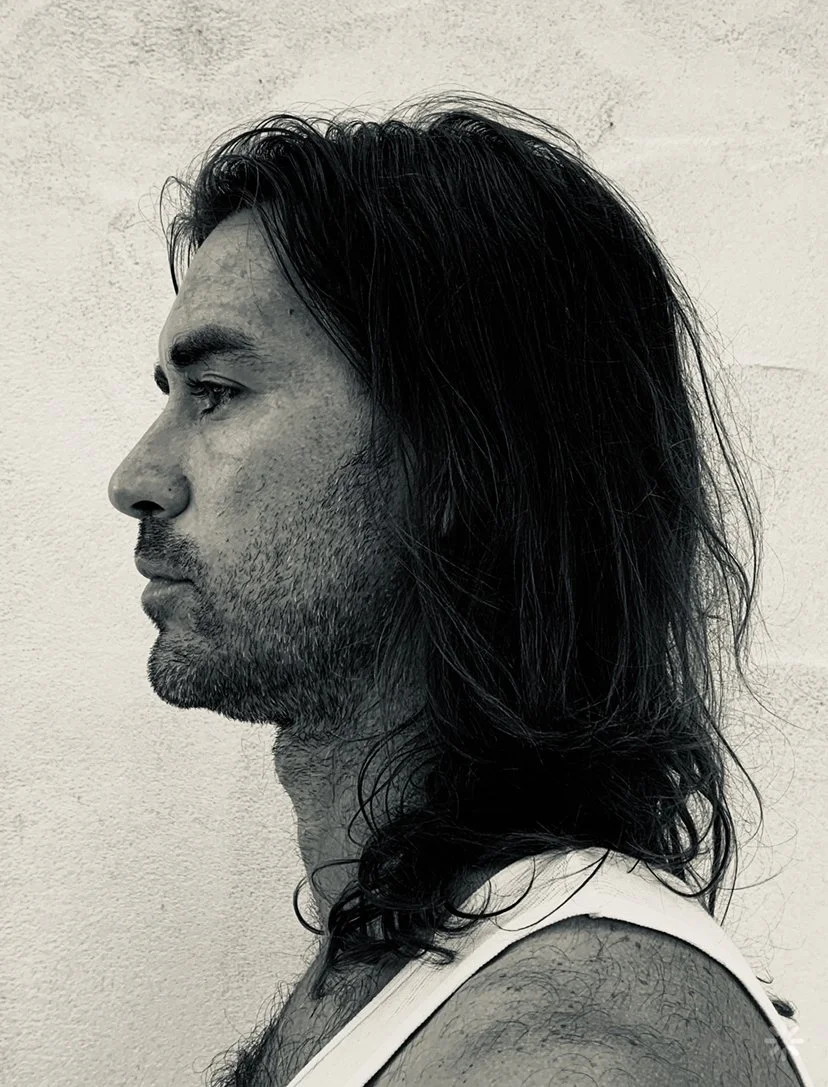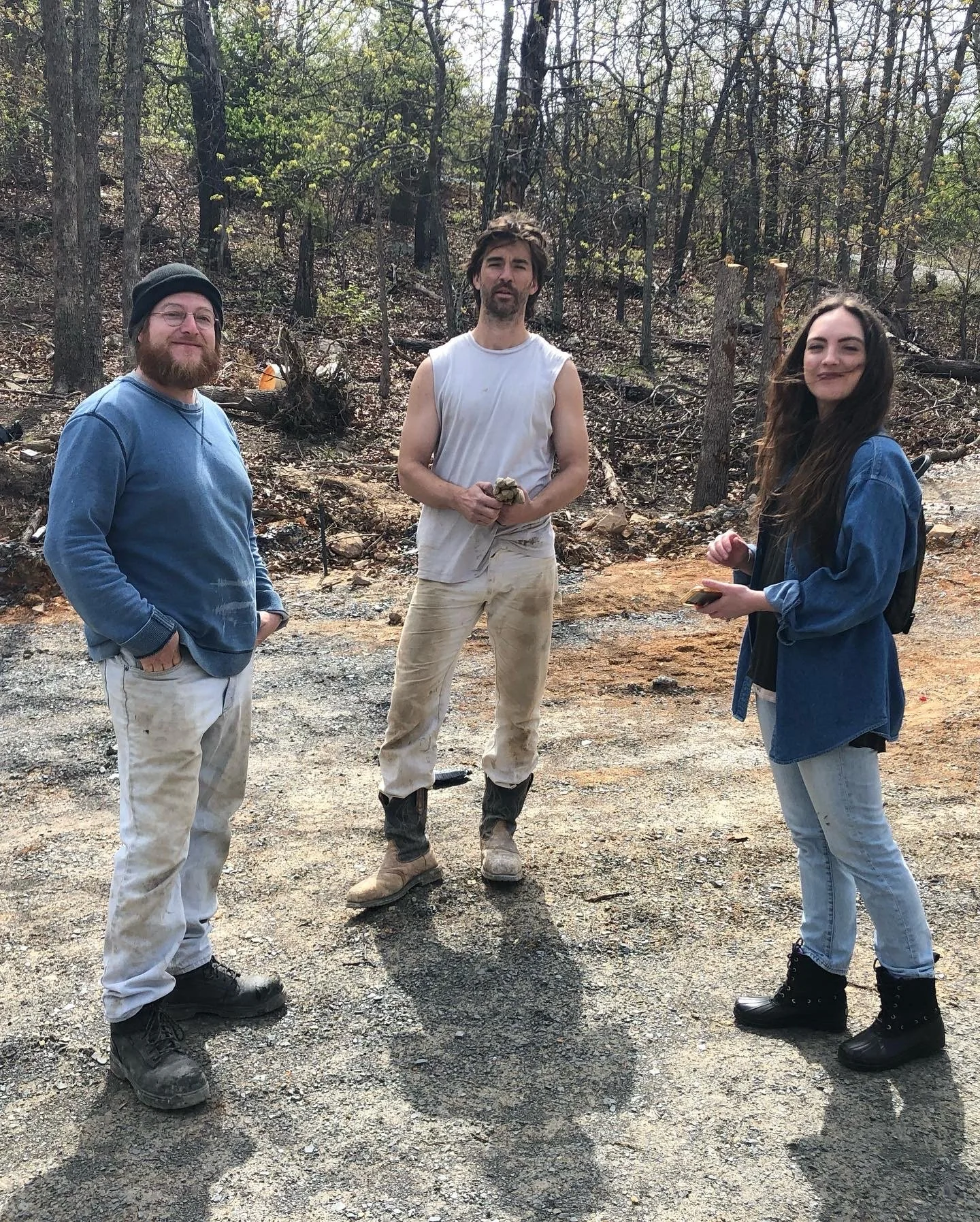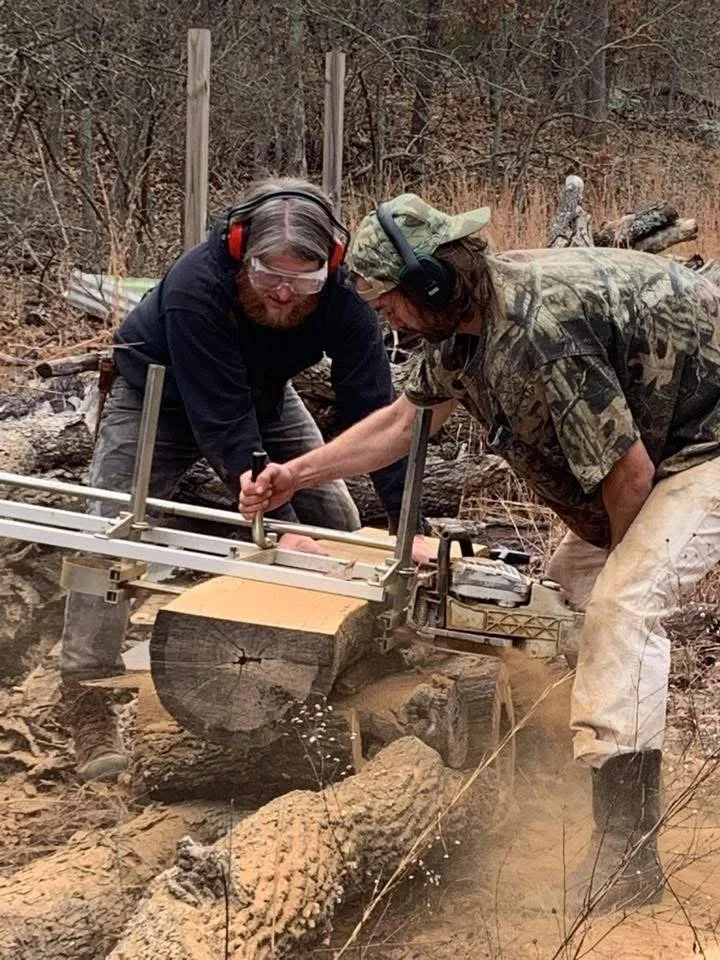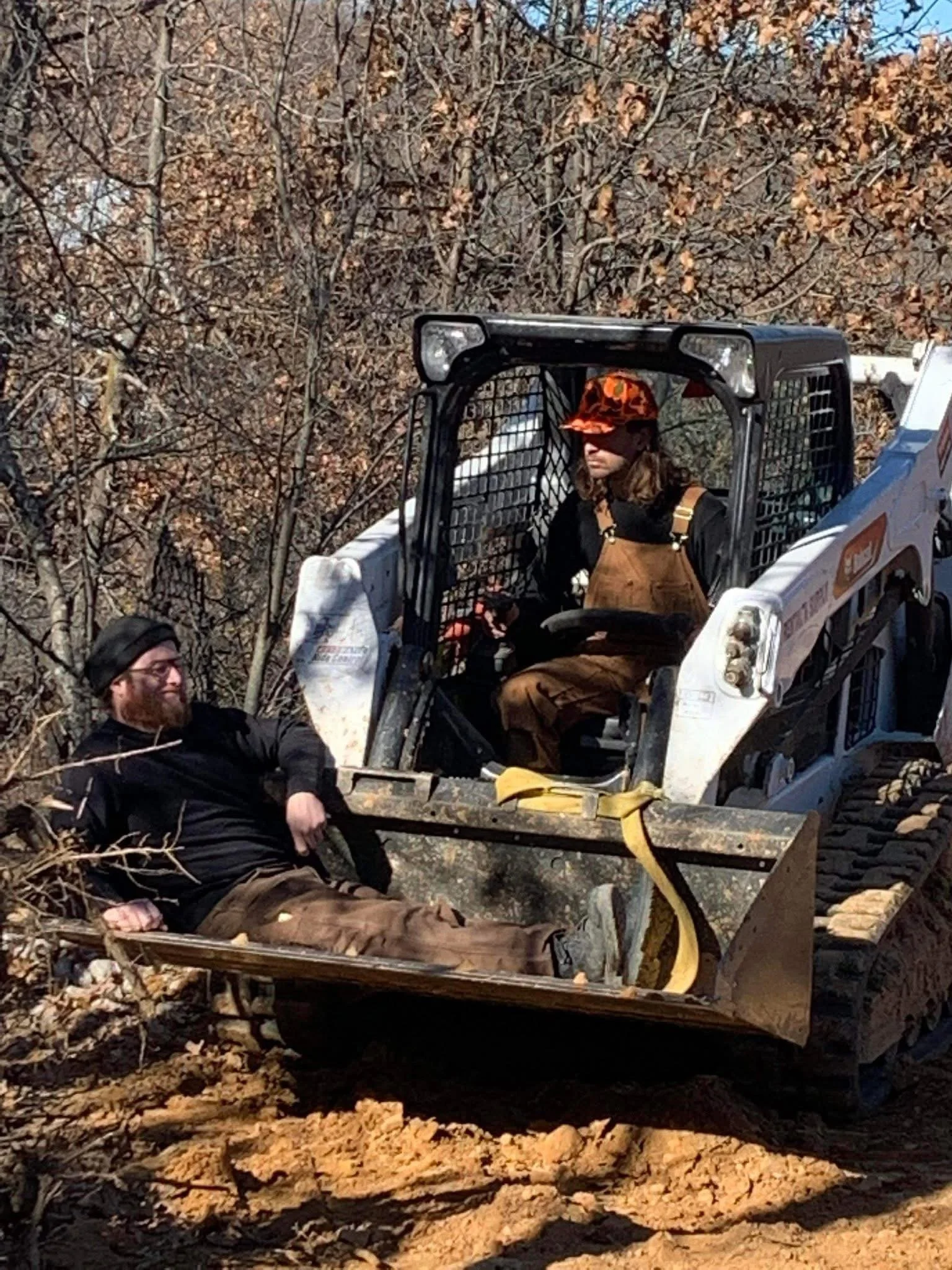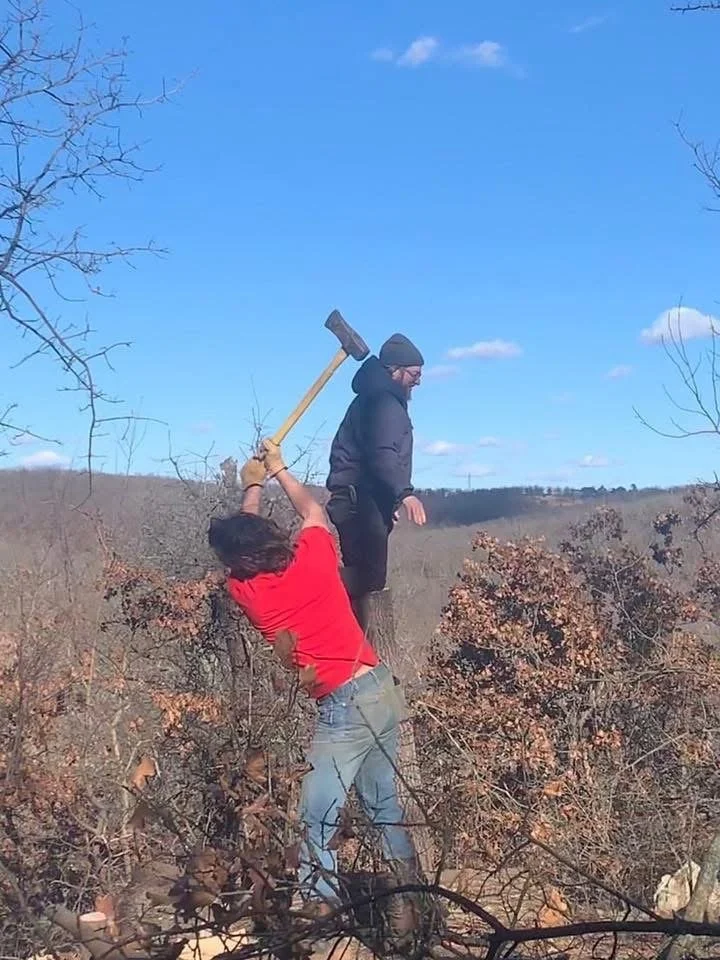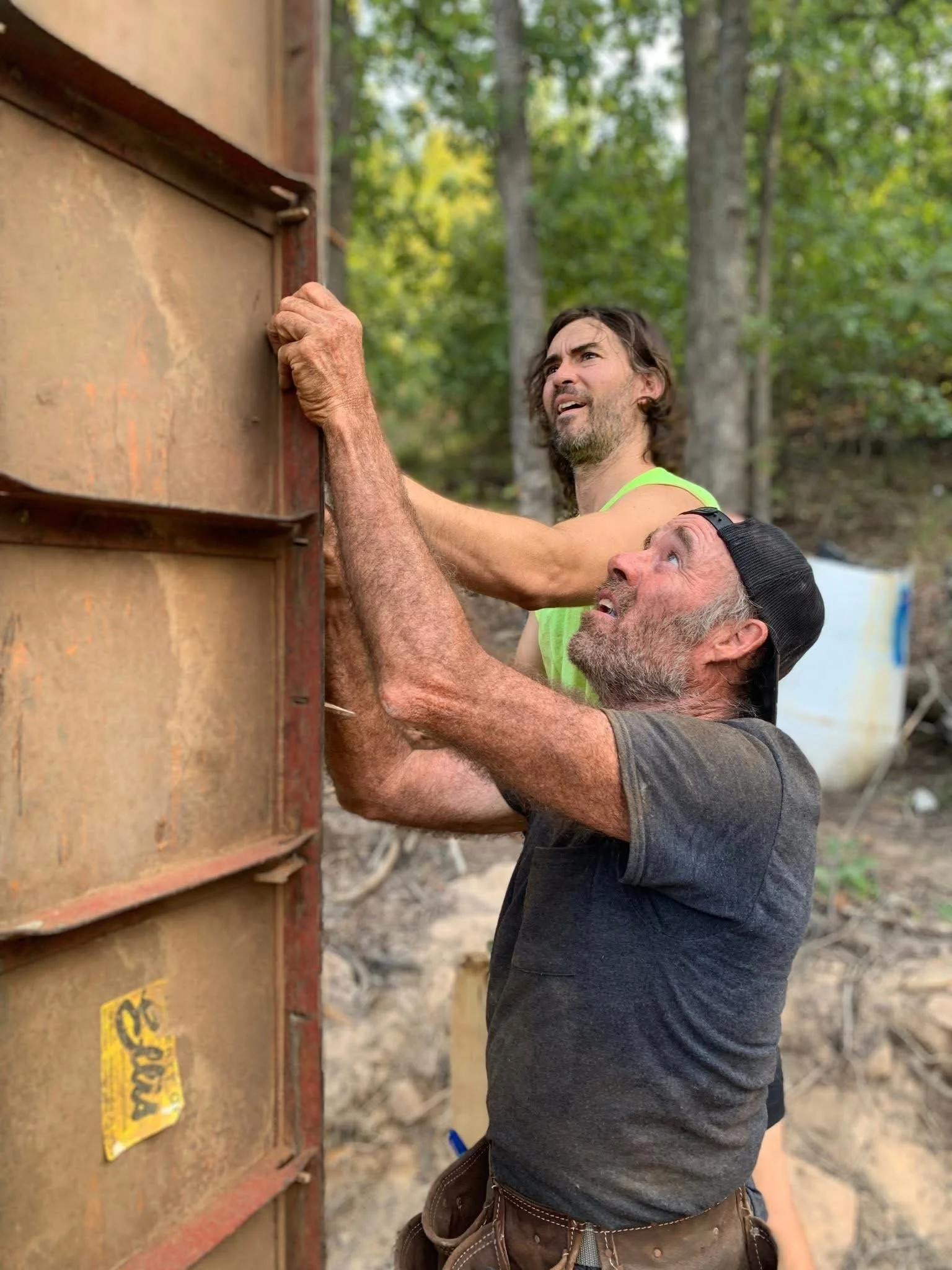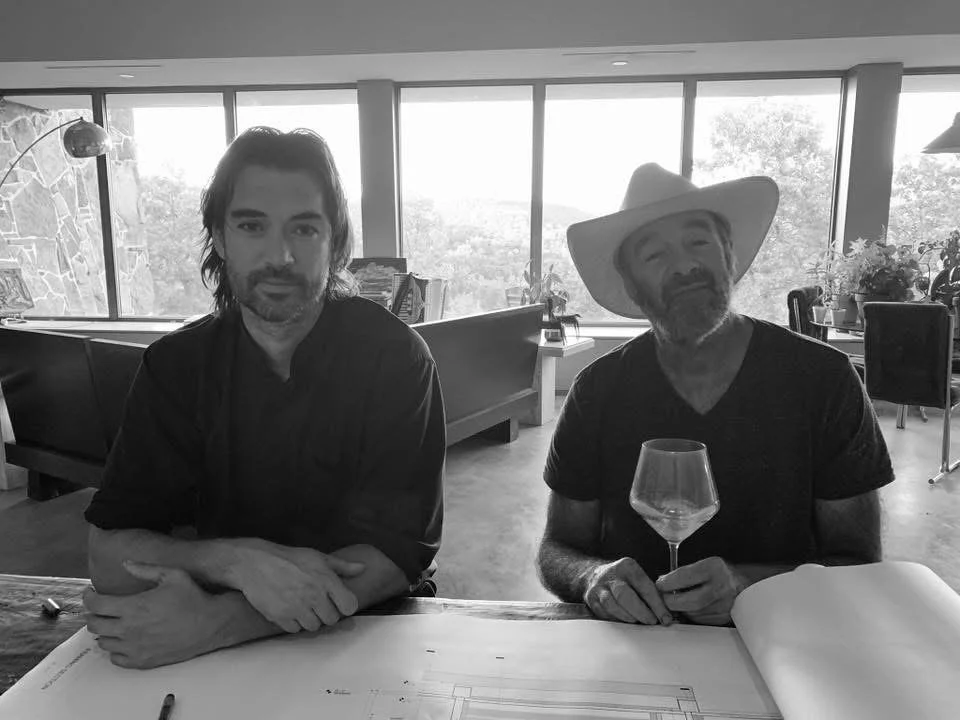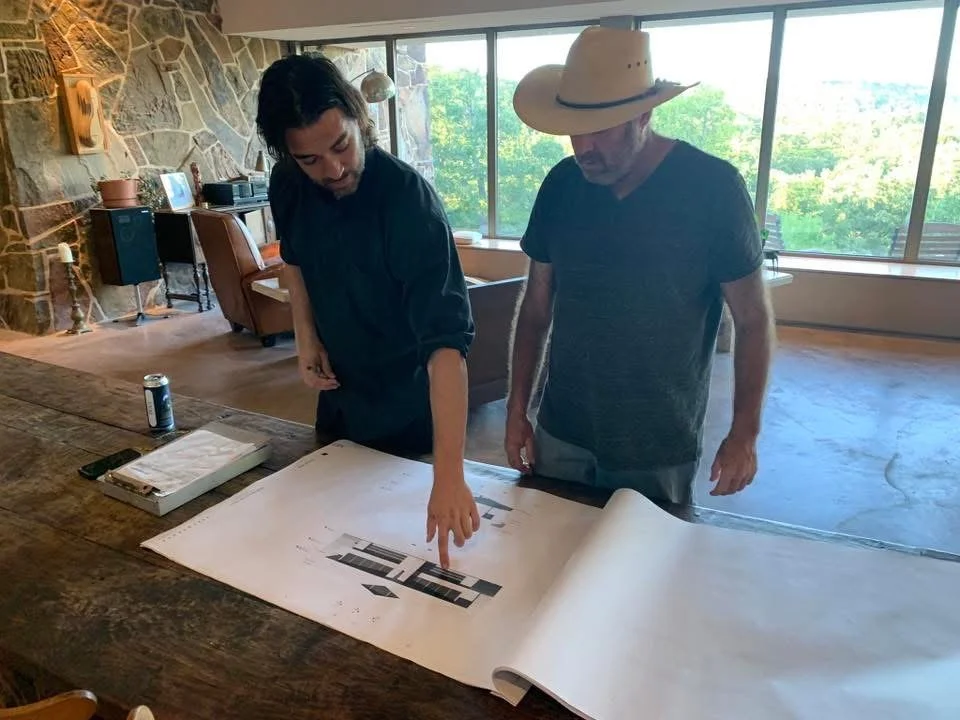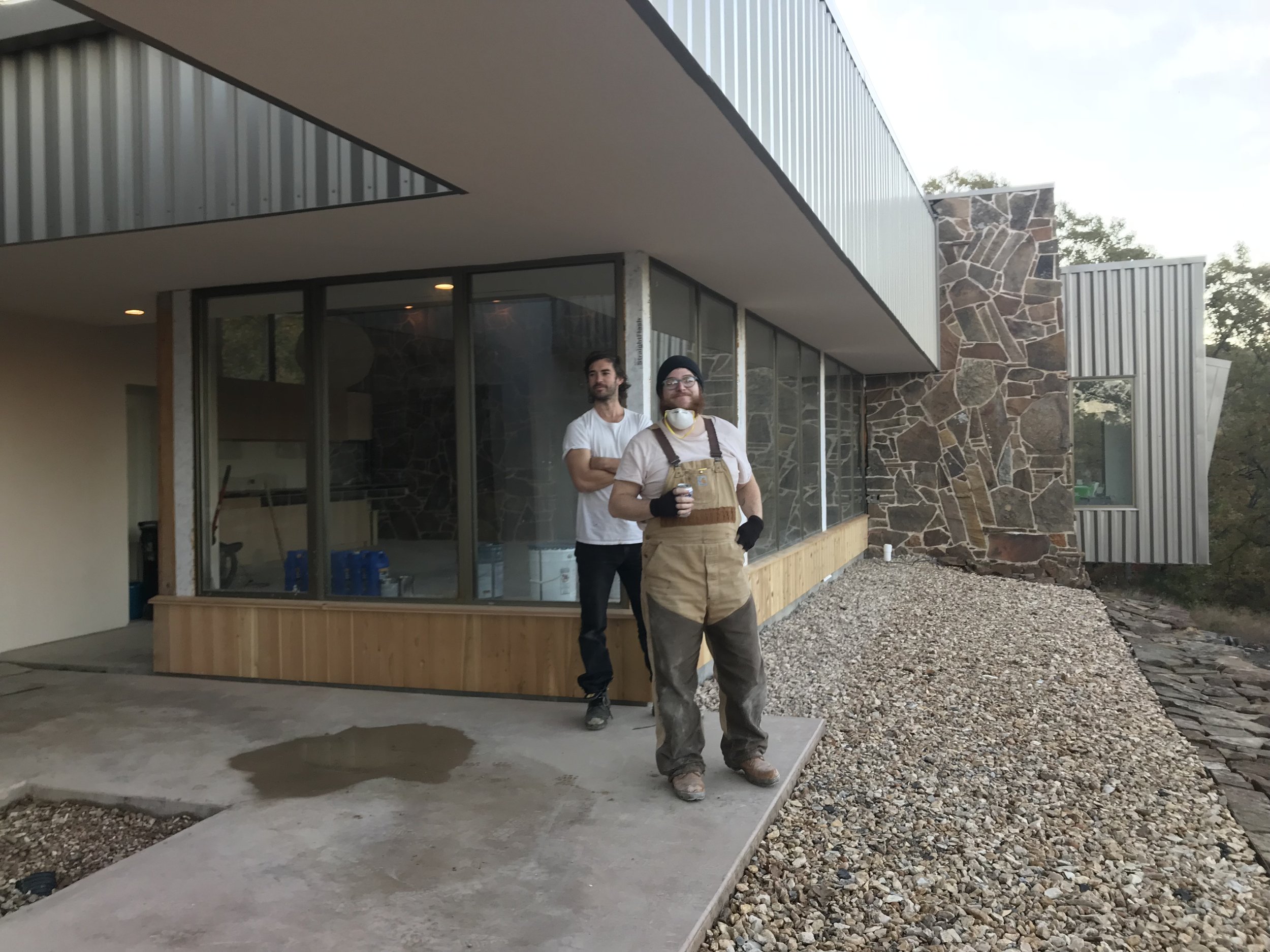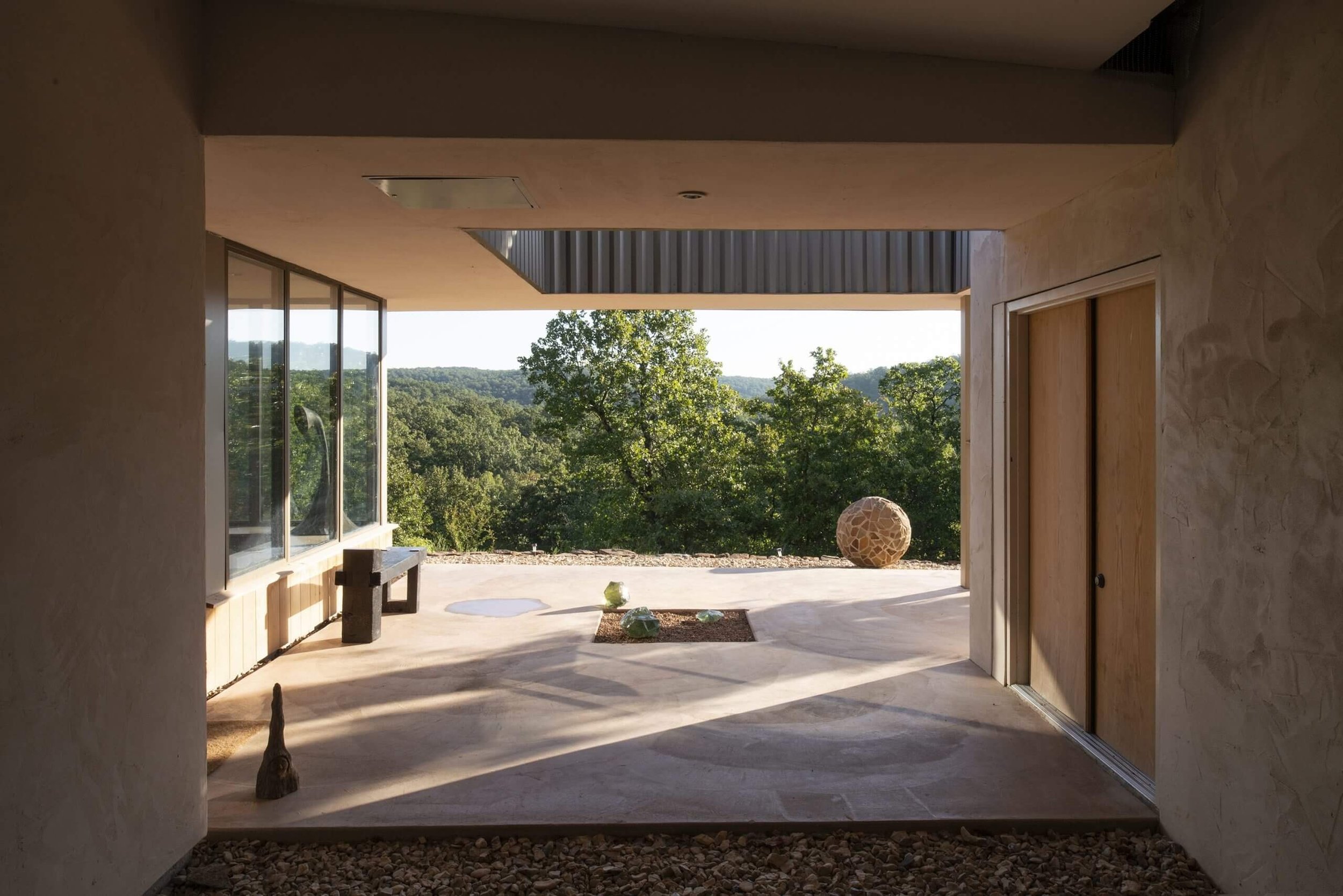The Meaning of Architecture
The Story of Wild Mountain Studios
BY Anjelica Lindsey
“You pile up associations the way you pile up bricks. Memory itself is a form of architecture.”
In 2016, Mark Kuykendall, Caleb Reed and I purchased five acres of land together in Osage County with the intention of building homes, a music production studio, and a life rooted in friendship and creativity. It was a time marked by shared vision and sincere anticipation of living near one another and cultivating a sense of enduring communion.
The ARCHITECT
Caleb John Reed is a gifted architect whose work reflects a deep sensitivity to landscape, material, and place. Holding a Master of Architecture from University of Kansas, his professional journey took him to renowned firms across the globe, including Marmol-Radziner in Los Angeles, Arkitektfirma Helen & Hard in Norway, and Marlon Blackwell Architects in Fayetteville, before bringing him home to Oklahoma, where he worked with Freese Architecture in Tulsa and developed his own studio practice, FIELDSPACE.
The Land
It was 2015, and my husband Mark and I were searching for a home where our recording studio could finally bloom into its potential space – perhaps even more the focus than the house itself. This was our priority and it felt impossible; no garage or spare room ever quite worked. Caleb, Mark’s childhood best friend, was still finishing a house in the Hollywood Hills at the time, and told us plainly: find a piece of land, and he would design our home.
But the story started much earlier. Unbeknownst to us at the time, myself, Mark and Caleb had each been quietly drawn to the Wild Mountain region since the 1990’s. Caleb and Mark spent formative years exploring 300 acres at the Ahava Community School, land nearly connected to Wild Mountain, where, alongside friends, they built their first structure—a mudded straw hut with a satellite dish as a roof. That experience that would go on to inspire Caleb’s formal pursuit of architecture.
Meanwhile, in my formative years, I found my own way up Old North Road, where my sister was building a home at the end of a country development. I visited throughout construction, and upon completion, spent long stretches there writing songs, slowly learning the rhythm of the land—where scorpions, ticks, deer, wild boar, and turkey passed through freely. It now seems inevitable that we would one day return to this place together, to build lives rooted in both nostalgia and vision.
Drawn by those childhood memories of music on Old North Road in Osage County, Oklahoma, Mark and I drove out to Wild Mountain and found the spot—perched on the side of Lefko Hill, fully amongst the tallgrasses and oaks at their meeting where prairie became ancient mountain. Caleb leapt into action from Los Angeles, making calls, researching, and confirming the site could work for his designs.
That same week, Mark and I met the Osage allottee and owner of Wild Mountain, Doug Martin, an Osage citizen, on Mustang Trail, a road he had built and named for his horses. At 80 years old, charming Doug hiked us up and down those hills like a man half his age; land he clearly loved and knew by heart.
After our hike, Doug asked if Mark and I wanted to see his home, and we said yes without hesitation. We climbed into his 1991 white Jeep Cherokee and to his gate where his white horse, Laser, stood by in a golden valley. We wound our way uphill to his fearless, fully off-grid house perched high on a steep ridge, the road near vertical at times. The moment we stepped inside, we were humbled. The sandstone floor and roaring fireplace, carved wood antique furniture, sprawling vaulted space with views for miles, and a long wooden table set for fellowship created a sacred beauty.
Doug’s wife, Marie, stood over a wood burning stove, stirring a great pot of chili, glowing. The communion between people, place, and purpose was so palpable we stood in quiet awe.
I asked Doug, “What do you do when it gets icy out here?”
“I have a Jeep,” he said.
Soon, Caleb called from California with news: the kind of creative life we were building wasn’t possible for him as an architect with a dream of building in LA—and he was coming home to Tulsa. He wanted to join us and build together. We brought him in completely, no hesitation, welcoming him as Mark’s brother and as our partner in this vision to make a life in the country.
I called Doug and explained we were artists hoping to live on Wild Mountain. He said, “That’s got to count for something!”
He offered to carve off a steep, unplatted piece of land for us, tough land, like his. Caleb didn’t flinch. He was fearless about building on a grade, and we charged ahead, full of energy and vision.
Another call came from Caleb. “I have bad news,” he said. “Doug died.”
We were stunned, heartbroken. Especially after seeing Doug in great health hiking the hills – But unexpected sepsis had claimed him.
Caleb continued the conversation with Doug’s wife, Marie, who carried Doug’s promise forward. She vowed to help us plat the land, and so we kept going—our dream still alive, because of the generous people and the deep connections that made Wild Mountain more than just a place.
Marie did fulfill Doug’s promise. Mark, Caleb, Marie and I hiked all throughout the hills together, through her ornamental gate (she called it “the fancy gate.”) She opened up to us: She had no children, and we would become hers. Our dream of being on Wild Mountain with this inspiring chosen family glowed inside of us.
Caleb, Marie, Lindsey, photo by Mark, hiking to scout our land.
Marie brought us up to her house where she was now living alone for the first time in all those years without Doug. Caleb fell in love with their home, saying, “This is one of the top architectural experiences of my life.”
Doug and Marie Martin home at Wild Mountain, photo by Caleb John Reed
We signed contracts to buy our part of Wild Mountain on Doug and Marie’s austere wood table, went home and celebrated into the night with Mezcal Vago!
The table in Doug & Marie’s house
Shortly after formally acquiring our land, Caleb fearlessly climbed a very tall tree on our property, surveyed the horizon, and called down, “We’re going to have a view!”
That moment captured his spirit of optimism and attuned to the potential in both people and place.
Creative Origin
Caleb’s Drawings of our house ideas.
Designing our house and studio with Caleb was an act of deep listening. He wanted to know everything as he designed: how we lived, what mattered most, where the sun hit in the mornings, how we moved through a day. He sketched in real time at our house, conjuring courtyards and garden walls, flipping the studio from one side of the house to the other as we talked. The creative origin lived right there on our coffee table, surrounded by Stevie Wonder records and takeout tacos from El Rio Verde, alive, evolving, and full of joy. Mark was thrilled his childhood best friend was not only home, but ready to build a life of inspiration with us.
Caleb designed multiple iterations of our house, each one a deepening study in sound and space, designing more than just a studio. He poured over our books on acoustics, asking questions, sketching possibilities, chasing the perfect union of architecture and music. He designed a studio space within the bolt range and he imagined a home where every room could hold a sonic anomaly. A stone bathroom with a reverberant tower ceiling with glass chunks in the wall, and a living room with a stone wall as live acoustic treatment.
Construction
In Progress stone wall at Wild Mountain.
Stone wall near completion with a music setup on the ground.
VERNACULAR ARCHITECTURE OF THE MIDWEST
As we immersed ourselves in construction, we three were dreamers, armed with house drawings and shared bank accounts, gathering melted chunks of green glass slag, local sandstone in the dead of winter, fireside with our crowbars in the woods, and sunset pink dye powder dumping into a turning concrete truck, pouring it all into our vision.
Mark Kuykendall, Caleb Reed, Anjelica Lindsey at Wild Mountain. Photo by Gaylord Oscar Herron
Our inspiration was part Oklahoma, part cosmos: Bruce Goff’s wild forms in Bartlesville, Ozark giraffe masonry in tiny Midwest towns, the organic genius of Frank Lloyd Wright and his spiritual heir Eric, the haunting minimalism of Donald Judd in Marfa and New York, the utopian dream of Arcosanti, the surreal terrain of Joshua Tree.
We studied, sketched, swam in lakes and creeks, drove long distances. We fetched bathtubs and wood stoves on trailers while listening to Vangelis cassette tapes, dreaming of window light and reverse sunsets. We even rolled a concrete truck down our rough gravel driveway during construction. (“Amazing how the big bosses and their cranes had no trouble finding the house that day!” Caleb said.)
The rolled over concrete truck during Wild Mountain construction.
Caleb Reed and Fred Frampton, who joined us for both construction on Wild Mountain Studios as well as the Caleb Reed Home. Frampton also contributed designs and construction to another home adjacent to ours at Wild Mountain.
Meanwhile, Marie, alone now in the remote house on Wild Mountain without Doug, grew overwhelmed. She told us she had seen Doug in the woods and had decided it was time for her to leave. She offered us the furniture from their home and gently asked for our help. We were heartbroken to realize we wouldn’t have a life on Wild Mountain with either Doug or Marie, but we respected her decision.
Without hesitation, Mark, Caleb, and I gathered a crew of friends, rented a box truck, and returned to the house that had stirred our imaginations so deeply. We moved through the rooms with her one last time, carrying out pieces of a life well lived, lifting furniture together with reverence.
“I’m strong!” Marie proclaimed.
The grand wood table where we had signed the contract for our land became ours. Its fellowship crossed the ridge, from one wild dream to another.
Marie wrote us a private letter from the perspective of the table to convey the meaningful memories it had already been through and lay a foundation for its future in our home.
Building a Future
From 2016 to 2018, Caleb designed and co-built our home and studio with us at Wild Mountain in Osage County. It was a project that embodied his interest in vernacular form, environmental context, and collaborative process. His approach was rigorous and intuitive, shaped by a profound respect for the land. With reverence for every tree he cut down and the ancient land we were disturbing, he drew a silent picture of each tree in his sketchbook before firing up his chainsaw. He only removed what was absolutely necessary, and the wood was saved.
Caleb drew each tree before he cut it down.
Caleb held a quietly Machiavellian brilliance, calling himself “one-hundred percent Italian” even though he was not Italian at all. Charming, strategic, and unafraid to bend the rules like Robin Hood in service of something beautiful. Together, we schemed like rebels with blueprints, finding back doors and creative workarounds to make our unconventional artist dreams a reality in a world that often said no before it even looked.
During construction, we gave Caleb a high-end pair of steel-toe boots which he needed. He wore them every day on the build site. But one afternoon, one of his crew members showed up in desperate need. Without hesitation, Caleb took off those boots and gave them to him.
No matter how much we gave to him, he gave more in return. His generosity was never performative—it was instinctual, silent.
We moved into the completed home and studio on New Years Eve 2018, ringing in January 1, 2019 with our first morning waking up on the hill. We remained close partners with Caleb in ongoing design and building projects over the years that followed.
Caleb and Mark near the end of construction.
We threw Marie a heartfelt goodbye party before she left Wild Mountain for Colorado, sending her off with love and gratitude. She called us often after the move, her voice warm but wistful, always inviting us to visit. She said her new house was just a cookie-cutter place, nothing like the soul and beauty of her life on Wild Mountain. She missed the hills, the quiet, the meaning woven into every stone. When she visited our house, she walked to the wall and touched the stone in silence.
Caleb, Marie, Lindsey, Mark at Wild Mountain
Marie told us she still owned the nine acres of land across from ours and was dreaming of building a new home there one day so we could be together again. She said Caleb would design it, of course.
After completing our house, Caleb turned his focus to designing his own, drawing from the same philosophies, materials, and spirit, but exploring the alternate paths we had once only dreamed aloud. In 2021, Caleb began earth work and construction of his own home on our shared property, a long-envisioned design of twin organic post-modern villas.
Where ours stretched low along the hillside with a courtyard tucked inside, his rose like a tower with stacked balconies, reaching skyward and sidestepping the copperheads, a reflection of the same story told in a different voice.
Rooted in the same principles we had shared but with new and mounting challenges following the covid-19 pandemic, he pursued the work with clarity and determination.
Caleb’s drawing of his house at Wild Mountain.
We started the building process all over again with Caleb and the tiny, dear building crew we had come to love. In heat, mud, rain, or ice, Mark and I were there beside him every step, whether tying rebar cages with our own hands, digging post holes with the auger and hand bucketing out rainwater from them, building colossal form walls before a big concrete pour. All because he had done it for us, and now it was time for him to come home to Wild Mountain.
Caleb in his living room at Wild Mountain. Photo by Emily Benton
Along the way, I received word that Marie wasn’t well and that she was back in Tulsa under mysterious circumstances. I tracked her down and found her in assisted living, quietly slipping into dementia. I went to see her right away. She couldn’t remember the difference between Caleb or Mark, but she was trying. I hugged her goodbye, gently, knowing one more dream had left me.
We continued building his home, Mark, Caleb and more beloved crew, including Fred and many more. Days of driving the skid steer – steel, dirt, stone, brutality for our dreams. One day after a day of work, Caleb stood in the woods behind the site with us and spoke about the future, thinking back on those several years of intense physical labor.
He said to Mark and I, “Our forties are going to be fun, guys. This next chapter is going to be about comfort.” He reached out his hand to shake and said, “Let’s make a pact. Let’s get rich, and in twenty years, we’ll sell this place all together and move to Europe.”
We shook on it.
Caleb mixing pine tar to stain his cedar siding on his house at Wild Mountain.
From the earliest days, Caleb sketched detailed, hand-drawn maps of our property, laying out a thoughtful, living design for what would become the twin villas. Our master plan for the five acres at Wild Mountain began to take shape with our shared vision guiding every step. Our plans included winding trails with moments to encounter sculpture, a minimalist swimming pool, hot tubs heated with indirect fire, an outdoor gym, an underground cellar with a moss covered roof and containing an enormous stone fireplace, and generous meditative and healing gathering spaces centered around warmth, shared meals, and conversation.
FINAL DREAMS THAT NEVER CAME
Our final surrealist architectural dream we named the Sonic Chapel—a sculptural, multidisciplinary sanctuary inspired by Las Pozas in Xilita, Mexico and considering the regional ancient architecture of Indigenous peoples in our region. It would weave together elements of bathing culture, contemporary art, and communal gathering, serving as an incubator for music, visual art, and residency-based exploration. With Caleb’s help, we endeavored to make a way of life as part of nature; a place where creativity, health, and a spirit of togetherness could thrive.
But before those ideas could even take shape, construction was still ahead of us at Caleb’s house.
When Mark and I bought a 1969 Airstream, Caleb lit up at the idea. Ready to leave behind his apartment downtown, he saw it as a meaningful step toward fully transitioning to life at Wild Mountain. The Airstream, along with our guest room, was Caleb’s idea of a temporary home base during the final phases of his house construction.
All the while, we insistently enjoyed otherworldly snow hikes, analysis of great cinema from Wim Winders or David Lynch ‘til we passed out, and plenty of Montelpuciano d’Abruzzo. In the kitchen we built with our own hands, we cooked feasts of pasta from scratch and red mole with roasted chicken, we watched the giant moon explode over the hills.
It was in that same kitchen, one day, Caleb lifted his shirt and showed us the scars from emergency surgery.
He had colon cancer. He was 40.
We entered a new phase of architecture then—one not of plans and drawings, but of presence. Of holding space for each other through the hardest thing.
Starting in October of 2023, we walked alongside him through treatment and recovery efforts while continuing to support his creative vision and shared projects. We had new strategic meetings – This time, not about banks or design, but about navigating the healthcare system. We made meals and organic juices, left Tulsa and stayed in hotels while we dropped him off at treatments, all the while he was taking phone calls for window installers back at his Wild Mountain house.
Caleb and I visit architecture exhibition OUTRÈ WEST at OK Contemporary after picking him up from cancer treatment. Photo by Mark Kuykendall
What Remains
Sunrise at Wild Mountain
Caleb passed away on May 6, 2025, at the age of 42.
I didn’t know it at the time – but the last time he was ever able to come to our house at Wild Mountain, he continued the tradition of matching all the finishes of our two homes, bringing tiles to get an exact match of our floor color – To carry the shade of pink concrete into to his home.
Caleb never got to see the reflection of the trees with leaves in the windows of his house – so I was able to show him photos of his own home on his deathbed.
“Gorgeous,” he said. “My heart is there with you all on Wild Mountain.”
Not long after Caleb passed, I came across an old message he had sent us mentioning, almost in passing, that Caleb had once worked with Eric Lloyd Wright on his “pink concrete house” in Los Angeles before Lloyd Wright had died. It had slipped my mind until then. I looked up the house and was struck by the parallels: the sculptural sunset pink concrete, the sweeping, tapered design, the sense of a monument in progress—unfinished, but deeply intentional. Even the detail that Eric had lived in a trailer on the site mirrored Caleb’s intention to live in the Airstream.
Eric Lloyd Wright house, Malibu, California
I remembered the way Caleb lit up when he spoke of that project. Was some part of him, perhaps subconsciously, building his own symbolic echo of an unfinished monument he once loved? I’ll never know for certain. But the way symbols resurface, the way art and life fold into one another continues to reveal itself.
Caleb's passing is a profound loss not only of a life richly lived but the loss of our shared dreams, a future still unfolding. The home he began building for himself beside the one we built together, remains unfinished; a concrete monument to possibility.
Throughout our years of collaboration, one of Caleb’s lasting contributions was his ability to integrate joy into even the most demanding work, the joy of which we have benefitted every day. He believed in the discipline of design and the satisfaction of labor done well. That ethos—of finding meaning through rigor and delight in the process—even the process of either life or death, is something we will carry with us always.
What remains?
“Architecture is Frozen Music” is a dictum usually attributed to German Poet Johann Wolfgang Von Goethe.
Perhaps our music, built of these walls, can be a testament to the meaning of architecture.
Caleb in his driveway. Photo by Gaylord Oscar Herron

